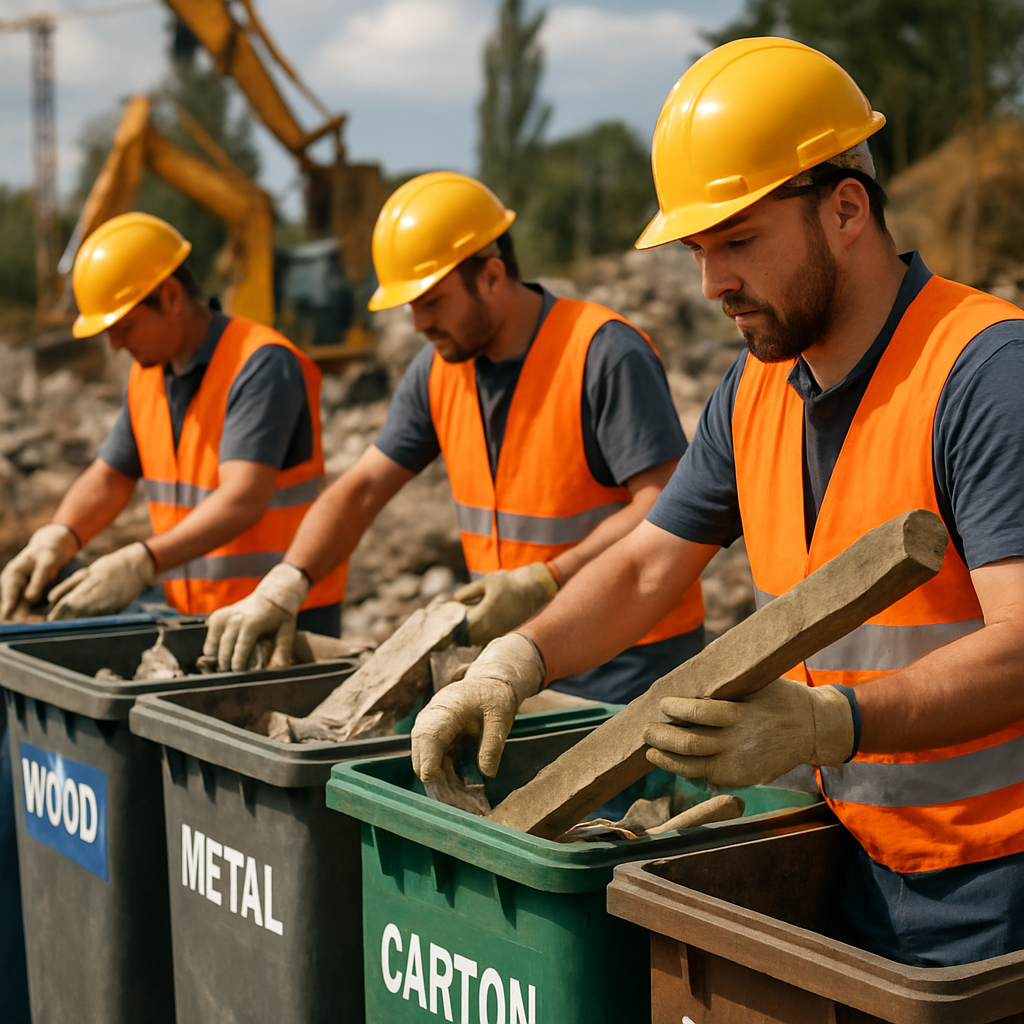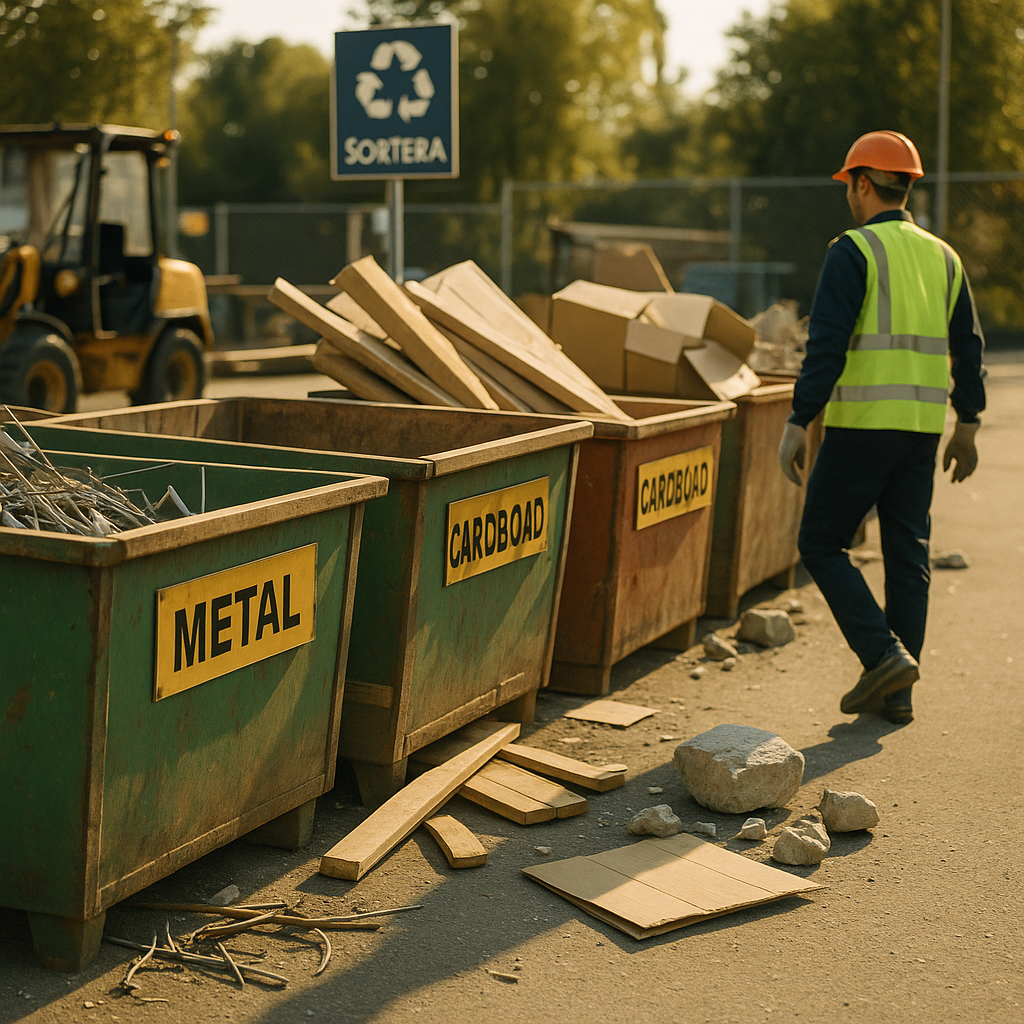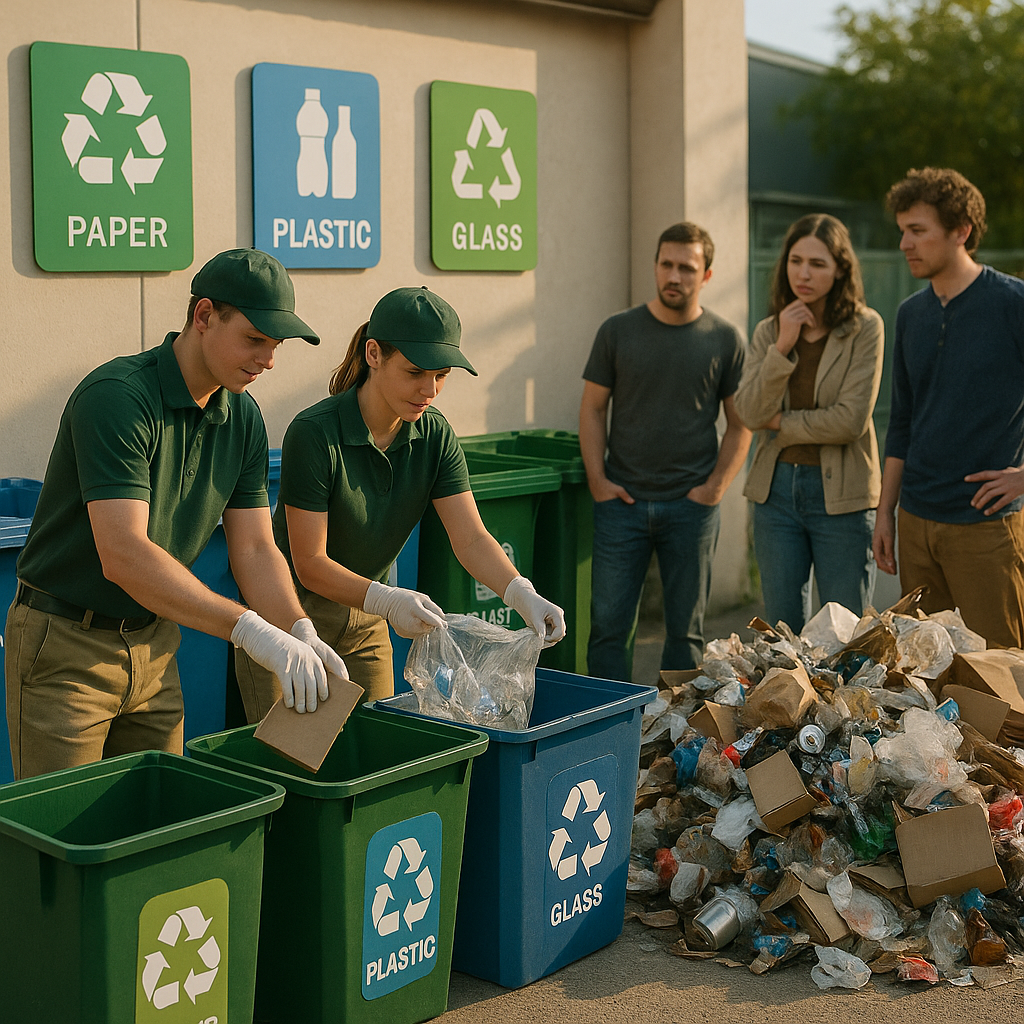5901 Botham Jean Blvd, Dallas, TX 75215
The Importance of On-Site Recycling in Construction
August 14, 2025Construction and demolition waste make up nearly 30% of all waste generated worldwide. This vast amount represents millions of tons of potentially reusable materials being sent to landfills each year. As urban development accelerates, sustainable waste management practices are essential.
On-site recycling of construction and demolition (C&D) materials offers a practical solution to this growing challenge. This method involves collecting, sorting, and processing materials directly at construction sites, rather than transporting them to distant landfills. The practice turns potential waste into valuable resources for immediate reuse.
For construction companies facing rising disposal costs and stricter environmental regulations, on-site recycling offers numerous benefits. It notably reduces transportation expenses, minimizes environmental impact, and aids in meeting sustainability requirements. By implementing effective on-site recycling programs, construction projects can achieve waste diversion rates of up to 85%, offering substantial cost savings while contributing to a more circular economy.
What Are the Key Methods for On-Site Recycling?

On-site recycling at construction sites falls into two categories: source-separated recycling and commingled recycling. Each approach offers distinct advantages and challenges for construction waste management professionals aiming to maximize material recovery and meet sustainability goals.
Source-separated recycling involves using multiple dedicated containers, each designated for specific materials like wood, metal, concrete, or cardboard. Workers sort waste materials at the point of generation, placing each type into its corresponding container. This method requires careful planning and clear labeling to ensure proper sorting.
Commingled recycling, also called single-stream recycling, uses one container for all recyclable materials. Everything goes into the same bin, with sorting done later at an off-site facility. This simplifies collection on the site but shifts the sorting burden to specialized processing centers.
Source-Separated Recycling: Higher Quality, More Management
Source-separated recycling delivers superior material quality by preventing cross-contamination between different waste streams. When wood waste isn’t mixed with concrete debris or metal scraps, each material maintains its purity and value. This cleaner output typically commands higher prices from recyclers and ensures more materials are recycled rather than sent to landfills.
A key advantage of source separation is the higher diversion rate it achieves. By keeping materials separate from the start, a greater percentage of construction waste avoids the landfill. Studies show source-separated systems can achieve recycling rates up to 90% for certain materials compared to commingled systems’ lower recovery rates.
However, source separation requires more physical space on the construction site. Multiple dumpsters occupy valuable square footage that might otherwise serve for material storage or equipment staging. On tight urban sites, this space requirement presents a challenge for project managers.
This method also demands more management oversight and worker training. Project managers must establish clear protocols, train workers on proper sorting, and monitor compliance. Workers need to understand which materials go in which containers, increasing the management burden on site supervisors.
Commingled Recycling: Convenience with Compromises
Commingled recycling simplifies waste management processes on construction sites. Workers don’t need to make sorting decisions—all recyclable materials go into one container. This streamlined approach saves time and reduces the need for extensive worker training in waste segregation.
The single-container approach requires less space on the construction site. One dumpster occupies minimal area while still accommodating all recyclable materials. For projects in dense urban areas or with limited space, this efficiency proves valuable.
Collection costs are typically lower with commingled systems. Fewer dumpsters mean fewer pickups and deliveries, reducing transportation expenses. The simplified logistics translate to cost savings appealing to budget-conscious project managers.
The major drawback is in material quality and recovery rates. When different materials mix, contamination increases significantly—glass breaks and embeds in other materials, paper products get soiled by food waste or liquids. This contamination reduces the percentage of materials ultimately recycled.
Processing costs are higher with commingled recycling since sophisticated sorting equipment and additional labor are needed at the processing facility. While the site saves on collection costs, the overall system bears higher expenses for material recovery.
| Factor | Source-Separated Recycling | Commingled Recycling |
| Material Quality | Higher due to reduced contamination | Lower due to mixed materials |
| Diversion Rate | Higher, up to 90% | Lower |
| Space Requirement | More space needed for multiple containers | Less space required with one container |
| Management & Training | More management and training required | Less training needed |
| Collection Costs | Higher due to multiple dumpster rentals | Lower with fewer dumpsters |
| Processing Costs | Lower as materials are already sorted | Higher due to advanced sorting technology required |
Choosing the Right Approach
The decision between source-separated and commingled recycling depends on project-specific factors. Sites with ample space and strong management systems may benefit most from source separation. Projects facing space constraints or tight budgets might find commingled systems more practical despite lower recovery rates.
Some projects implement a hybrid approach, using dedicated containers for high-volume materials like concrete, wood, and metal while collecting lower-volume recyclables in a single commingled container. This balances space requirements with recycling effectiveness.
Local infrastructure also influences the choice. Some regions have advanced material recovery facilities capable of effectively sorting commingled waste, while others lack such technology. Understanding local recycling facility capabilities helps determine which approach will yield the best results.
Regardless of the method chosen, clear communication and proper signage remain essential. Workers need to understand the recycling system in place and receive adequate training on proper material handling. Even the best-designed system fails without consistent implementation.
What Materials Can Be Recycled On-Site?

On-site recycling offers significant environmental and cost benefits for construction projects. Processing materials directly at the job site eliminates transportation costs and reduces the project’s carbon footprint. Here are some common construction materials that can be effectively recycled on-site.
Concrete, Brick, and Masonry
Concrete is a versatile material for on-site recycling. Using mobile crushers, concrete debris can be processed into various sizes of aggregate right where it is generated. These recycled aggregates are suitable for:
- Base or subbase materials for new roads and pavements
- Fill for utility trenches and foundation backfill
- Drainage material when crushed to appropriate sizes
Brick and masonry undergo similar processing. Clean, crushed brick makes excellent pathway material or decorative mulch for landscaping. Successful concrete recycling requires proper separation from contaminants like wood, plastic, and reinforcing steel before crushing.
Wood Materials
Wood waste from construction sites presents various recycling opportunities. Clean, dimensional lumber can be salvaged and reused in non-structural applications like blocking, forming, or temporary structures.
Wood that cannot be reused whole can be:
- Chipped on-site for mulch used in erosion control or landscaping
- Processed into particles for ground cover in site stabilization
- Used as biomass fuel for heating or energy production if facilities are available
For optimal recycling, remove all nails, screws, and hardware from the wood before processing. Keep pressure-treated wood separate, as it contains chemicals that limit recycling options.
Metals
Metals have high value among recyclable construction materials. Steel, aluminum, copper, and brass can all be collected on-site. While these metals will often be processed off-site, sorting and storing them properly on-site maximizes their recycling value.
Structural steel components can be directly reused in other construction areas when projects are designed with this possibility in mind. Rebar can be collected separately from concrete debris using magnets during the crushing process, then bundled for recycling.
Gypsum and Drywall
Clean gypsum drywall can be ground on-site and used as a soil amendment, adding calcium and sulfur to the soil, which improves its structure and fertility. This is particularly beneficial for construction sites that include landscaping components.
To prepare drywall for on-site recycling:
- Remove paper backing when possible
- Keep gypsum free from paint, adhesives, and other contaminants
- Process into small particles for better soil integration
Note that gypsum with paper backing can still be used but will decompose more slowly in soil applications.
Asphalt
Asphalt pavement is nearly 100% recyclable on-site. Using specialized equipment, existing asphalt can be ground and mixed with new binding agents to create fresh paving material. This process, called cold in-place recycling, can be performed directly on the construction site.
Recycled asphalt performs exceptionally well as base material for new roads and parking areas, often matching or exceeding the performance of virgin materials.
Packaging Materials
Construction sites generate significant quantities of packaging waste, much of which can be returned to suppliers for reuse:
- Wooden pallets can be returned to material suppliers for reuse or repurposed on-site
- Plastic wrapping can be collected for recycling
- Cardboard can be baled on-site and sent for recycling
Establishing a return program with suppliers at the beginning of a project creates an efficient system for managing packaging materials.
| Material | Recycling Method |
|---|---|
| Concrete | Crushed into aggregate for roads or new concrete |
| Wood | Reused as lumber, mulch, or biomass fuel |
| Metals | Melted and reformed (e.g., steel, aluminum, copper) |
| Asphalt | Recycled into new pavement |
| Bricks | Cleaned and reused or crushed for fill material |
| Plastics | Processed into new products |
| Gypsum | Recycled into new drywall or used in agriculture |
Benefits of On-Site Material Recycling
Recycling materials directly on the construction site offers multiple advantages beyond waste reduction. These benefits include:
- Reduced transportation costs for both waste disposal and new material delivery
- Lower project expenses through material reuse and decreased landfill fees
- Improved project timelines since recycled materials are immediately available
- Enhanced sustainability credentials for the project and construction firm
- Meeting regulatory requirements for construction waste diversion
Successful on-site recycling relies on planning. Identifying recyclable materials and setting up processing protocols before construction begins ensures maximum recovery and reuse throughout the project lifecycle.
What Are the Benefits and Challenges of On-Site Recycling?

On-site recycling transforms waste management from a cost center into a strategic business advantage. When companies process recyclable materials directly at their facilities, they unlock multiple benefits while facing several practical challenges. Understanding this balance is crucial for organizations considering implementing or expanding their on-site recycling programs.
Economic Advantages of On-Site Recycling
The financial benefits of on-site recycling extend far beyond waste reduction. Companies effectively using recycling programs often see significant cost savings across various operations.
Disposal costs decrease substantially when materials are recycled rather than sent to landfills. With landfill tipping fees rising in many regions, businesses can reduce these expenses by up to 50% through strategic recycling initiatives. A medium-sized construction project, for instance, might spend $25,000-$35,000 in landfill fees alone using traditional disposal methods, but could cut this to $10,000-$15,000 through recycling.
Beyond cost reduction, on-site recycling creates revenue opportunities. Materials like metals, particularly steel, copper, and aluminum, hold significant value when properly sorted and recycled. A typical commercial construction project can generate $3,000-$8,000 from selling recyclable materials that would otherwise incur disposal costs.
Transportation expenses decrease notably. On-site processing eliminates or reduces the need to haul materials to distant processing facilities, saving on fuel, vehicle maintenance, and labor costs. This benefit is particularly pronounced for companies dealing with heavy materials like concrete or metals.
| Waste Type | Traditional Disposal Cost (per ton) | On-Site Recycling Cost (per ton) | Cost Savings (per ton) | Savings Percentage |
|---|---|---|---|---|
| Concrete | $15.50-$19.50 | $7.50 | $8-$12 | 51-62% |
| Asphalt | $15-$20 | $6.70 | $8.30-$13.30 | 55-67% |
| Clean Wood | $65-$85 | $25-$35 | $30-$60 | 46-71% |
| Mixed Construction Debris | $75-$105 | $42-$55 | $20-$63 | 27-60% |
Environmental Impact Benefits
The environmental advantages of on-site recycling extend beyond the immediate business premises. Companies implementing these programs contribute meaningfully to broader sustainability goals.
Reducing landfill burden is one of the most direct environmental benefits. A single commercial construction project using on-site recycling can divert up to 7,000 cubic yards of waste from landfills – equivalent to filling two Olympic swimming pools. This preservation of landfill space becomes increasingly critical as available disposal sites grow scarcer.
Carbon footprint reduction occurs through multiple mechanisms with on-site recycling. Manufacturing cement, a key component in concrete, accounts for approximately 8% of global CO2 emissions. By crushing and reusing existing concrete as aggregate on site, companies avoid these emissions while preserving the embodied carbon already invested in these materials.
Resource conservation extends to various materials. Recycling one ton of steel saves approximately 2,500 pounds of iron ore, 1,400 pounds of coal, and 120 pounds of limestone that would otherwise be mined. Similarly, glass recycling conserves significant natural resources and requires 30% less energy than manufacturing new glass from raw materials.
Operational and Reputational Advantages
On-site recycling streamlines project workflows when properly implemented. With minimal waste hauling and reduced waiting times for external waste management services, projects often see faster completion timelines. The Seattle commercial redevelopment project in 2022 demonstrated this efficiency by recycling over 85,000 tons of concrete on-site, saving approximately 8,500 truck trips and significantly reducing project duration.
Regulatory compliance becomes more straightforward with on-site recycling programs. Many municipalities now require minimum recycling rates for construction and demolition projects. Companies with established recycling systems avoid potential fines and project delays associated with non-compliance.
Brand reputation enhancement follows from visible sustainability efforts. Customers, employees, and investors increasingly favor companies with demonstrated environmental commitments. Effective on-site recycling programs allow businesses to meet these expectations and showcase their commitment to environmental stewardship.
Practical Challenges of Implementation
Space constraints present significant hurdles for on-site recycling. Urban construction sites and manufacturing facilities often have limited room for setting up sorting stations and placing the necessary containers for different material streams. Companies must carefully plan their site layout to accommodate recycling needs without impeding core operations.
Material contamination poses another major challenge. When recyclable materials become mixed with non-recyclable items or different recyclable streams cross-contaminate each other, the value and recyclability of the materials decrease. For instance, wood contaminated with paint or other chemicals becomes more difficult and sometimes impossible to recycle properly.
Training requirements add another layer of complexity. Workers need proper education on what materials can be recycled and how to sort them effectively. This necessitates ongoing training programs and supervision to ensure compliance with recycling protocols. Without adequate training, even well-designed recycling systems may fail due to improper material sorting.
Quality concerns can arise with on-site processed materials. The European Demolition Association notes that on-site recycling operations may produce lower-quality recycled products due to limited cleaning facilities. This potential quality reduction must be balanced against the transportation and environmental benefits of on-site processing.
Overcoming On-Site Recycling Obstacles
Innovative solutions have emerged to address many common on-site recycling challenges. Mobile recycling units offer an effective response to space constraints. These portable systems can be brought directly to facilities, enabling materials to be processed on-site without requiring permanent infrastructure. This reduces the need for large sorting areas while minimizing transportation costs.
Partnerships with specialized recycling facilities help address contamination issues. These facilities have the expertise and equipment to handle mixed or partially contaminated materials that might otherwise be difficult to recycle. Establishing relationships with such partners streamlines the recycling process.
Technology integration increasingly helps companies overcome recycling challenges. AI-powered sorting systems can identify and separate materials with high precision, reducing labor costs and improving recycling rates. These advanced technologies make recycling feasible even on challenging sites with space limitations or complex waste streams.
Staff engagement programs build recycling into company culture. When employees understand the environmental and business benefits of recycling, they become more committed to proper material sorting. Regular communication about recycling successes and ongoing education helps maintain this engagement over time.
Making the Decision: Is On-Site Recycling Right for Your Company?
Selecting between on-site and off-site sorting depends on several project-specific factors. Space availability often becomes a deciding factor on urban construction sites where room for multiple containers may be limited. Projects with strict sustainability targets might prefer on-site sorting for higher recycling rates, while those with tight space constraints might find off-site sorting more practical.
Budget considerations naturally influence this choice. On-site sorting generally requires more initial investment in equipment and training but can yield better financial returns through higher-quality recyclable materials and reduced transportation costs. Off-site sorting typically offers lower upfront costs but may result in smaller recycling rebates due to contamination issues.
Project location plays a crucial role in this decision. Sites located far from recycling facilities face higher transportation costs for off-site recycling, making on-site processing more economically attractive. Conversely, projects in areas with excellent recycling infrastructure might benefit from the specialized equipment available at dedicated recycling centers.
Conclusion: Embracing On-Site Recycling for a Sustainable Future

On-site recycling of construction materials is more than just a trend—it’s an essential practice for environmentally responsible and cost-effective construction. The benefits are clear and compelling. By recycling materials directly at construction sites, companies can significantly reduce waste heading to landfills while conserving valuable natural resources. This approach cuts disposal costs, minimizes transportation needs, and can even generate revenue through the sale of recyclable materials.
As environmental regulations tighten and the construction industry faces growing pressure to adopt sustainable practices, on-site recycling positions companies for long-term success. Implementing effective recycling strategies will provide competitive advantages through cost savings, enhanced reputation, and compliance with evolving standards. For expert guidance on construction waste recycling solutions for your project site, contact Okon Recycling at 214-717-4083.
